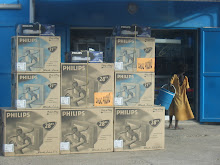
While preparing to leave Dakar, I was convinced that I would not miss the city or my life there. My move out was crazy, I had many separate issues to contend with such as dealing with a lying landlord from hell, handling the phone and electric companies disorganization, selling my furniture, quitting my jobs, plus living with the uncertainty of what my time in Morocco would be like. Now four months have passed since I boarded the Air Alergie flight to Casablanca and I miss Dakar daily.
In Dakar, I now realized, I was liberated. I had a nice apartment, good jobs, and could easily communicate. I often think about the lifestyle Otman and I were able to maintain. It was a privilege that we both acknowledge. We were living the good life. In Morocco, we had a great time but our life was very different. I was dependent on him to communicate most of the time. In Senegal, my Wolof “plateaued” at a certain level but it was enough to conduct simple conversations and get to where I needed to go. I used French as a crutch and therefore it improved immensely.
There are many aspects of life in Dakar that I long for regularly. I miss hearing the chants outside my living room window every Friday evening. I miss the smell of incense which pervades the streets, especially at night. I miss catching my neighbors in their secret rendezvous in the dark alley by my house. I miss knowing for certain that if I ever needed help, a band of people would come to my rescue. I miss my tailor, Alioune. I miss the sound of drumming. I miss being able to buy whatever I need, whenever I need it, from a corner store or a person selling goods. I miss knowing what the weather will be like since it rarely changes. Few sights compare to a Dakar sunset on the ocean or spending a day at the beach at Ile Ngor. I miss my friend Fabrice, who lives in Dakar, because without him, I am not sure how long I would have been able to stay.
This is not to that living in Dakar was heaven. I had to live with frequent power outages and feeling that I was constantly being cheated. Towards the end of my stint, I felt that everything was an uphill battle. The realities of living in a poor country began to wear me down. I do not miss waiting in line for six hours to pay a bill or being told to be patient. I don’t miss bargaining for taxis or the smell of exhaust fumes. I do not miss hearing rams bleat all day long or seeing them get washed in the ocean with household garbage floating about. I do not miss being hassle and hustled. I do not miss being conspicuous. Nor do I miss seeing talibes and abandoned women because they broke my heart each and everyday.
Now back in the US, I walk around NYC pointing out to myself which one of the street vendors are Senegalese. I made a music mix on my ipod that plays West African songs on loop. While listening to the mix on a recent trip into NYC, I felt an incredible urge to dance. Now, I am not one to dance, ever. I am very conscious of my body and hate to look like a fool. But here I was on Broadway feeling an incredible urge to mimic my host sisters from Yoff, which I suppressed. If I wasn’t in NYC, this dance would cause a bit of a scandal since it requires lifting up your shirt in a circular motion and jumping up and down like a Leprechaun.
I learned an incredible amount from living in Dakar. I labeled these lessons “Senegalese sensibilities”. Much of my Senegalese sensibilities are centered on interactions with people and general street smarts. Aspects of my Senegalese sensibilities have turned me hard and untrusting from daily dealings with hustlers. But other aspects have made me kinder and more patient from living around people who always share and take care of others. Because of my time in Dakar, I have garnered strong views on non-governmental organizations, expatriates, Islam, social welfare structures, polygamy, and African unity. I am thankful for all that I have learned and been able to witness. To me, Dakar has always been a place of dichotomies: rich and poor, happy and sad, political and apathetic, greedy and modest, hope and hopelessness, “authentic” and fake, humble and ostentatious, “traditional” and “modern”, etc. For me, these dichotomies have lent to a broader understanding of Dakar, Senegal, West Africa, Africa, and the world.
In sum, my experience in Senegal is and always will be a part of who I am.
Jamm ak jamm.
















